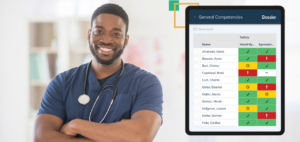Authored By:

Reinforcing Key Concepts for Healthcare Workers on the Go
Healthcare professionals face the challenge of staying up-to-date with the latest medical advancements while juggling their demanding work schedules. Traditional classroom-based learning often falls short of meeting their unique needs. This is where microlearning and just-in-time learning come into play as powerful tools to reinforce key concepts and support continuous learning, making it a perfect fit for healthcare workers constantly on the go.
What is Microlearning?
Microlearning is a pedagogical approach that delivers small, bite-sized units of information to learners. These concise and focused learning modules can take the form of short videos, interactive quizzes, infographics, or mini-games. The goal is to present information in a manner that is easy to understand, quickly consumable, and readily applicable to real-world scenarios.
Advantages of Microlearning for Healthcare Workers:
- Time-Efficient: Healthcare workers often have limited time for formal education. Microlearning allows them to learn during short breaks, commutes, or moments of downtime, maximizing their learning opportunities without disrupting their busy schedules.
- Targeted Learning: Microlearning focuses on specific learning objectives, making it easier for healthcare workers to find and access the information they need precisely when needed.
- Enhanced Retention: The condensed and focused nature of microlearning helps improve information retention. Regular reinforcement of key concepts leads to more profound and lasting learning outcomes.
- Accessibility: Microlearning content can be accessed on various devices, such as smartphones and tablets, giving healthcare workers the flexibility to learn on the go, anytime, and anywhere – some even use Virtual Reality (VR).
What is Just-in-Time Learning?
Just-in-time learning complements microlearning by providing learners with immediate access to information when they need it the most. It involves providing on-demand learning resources to address specific challenges or questions that arise during the course of their work.
Benefits of Just-in-Time Learning for Healthcare Workers
- Problem Solving: Healthcare workers often encounter unexpected situations and challenges during their clinical practice. Just-in-time learning equips them with the necessary knowledge and skills to address these issues effectively in real-time.
- Support Decision-Making: Access to accurate and relevant information can make all the difference in critical moments. Just-in-time learning ensures healthcare workers can quickly access guidelines, protocols, or best practices to inform their decisions.
- Performance Improvement: With immediate access to learning resources, healthcare workers can continuously improve their performance and remain competent in their roles.
- Confidence Boost: Knowing they can quickly find the information they need boosts healthcare workers’ confidence, increasing job satisfaction and improving patient outcomes.
The Synergy: Flipped Classroom and Microlearning
The flipped classroom, microlearning, and just-in-time learning form a powerful synergy in healthcare education. The flipped classroom model allows healthcare students to access foundational knowledge through microlearning modules before attending class, thus preparing them for more in-depth discussions during the in-person sessions.
Moreover, healthcare professionals can continue their learning journey beyond formal education by embracing microlearning and just-in-time learning. As they encounter challenges in their daily practice, they can reinforce their knowledge through brief, targeted learning modules. This continuous learning approach keeps them informed, skilled, and confident, which is essential in a rapidly evolving field like healthcare.
Conclusion
Integrating flipped classrooms, microlearning, and just-in-time learning is a game-changer for healthcare workers. It addresses their unique needs for flexible, accessible, and targeted learning while supporting continuous professional development.
As the healthcare industry advances, embracing these innovative approaches will undoubtedly contribute to a more competent, confident, and compassionate workforce, ultimately benefiting healthcare professionals and their patients. So, let’s flip the script on traditional learning and empower healthcare workers with the tools they need to succeed in their noble mission of providing quality care.




